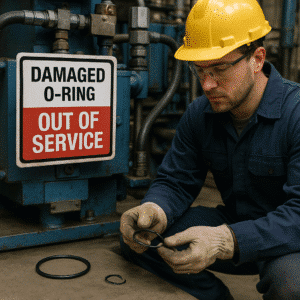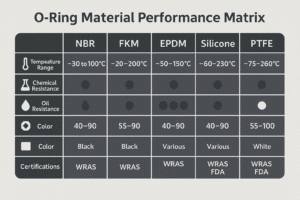When your hydraulic system faces extreme pressure, standard seals might fail. That’s where V-type seals shine.
V-type hydraulic seals, also called V-packings, are designed to handle high-pressure, high-frequency conditions with minimal leakage and superior longevity.
Let’s explore why V-type seals are the top choice in 2025—and how to pick the right configuration for your system.
What is a V-type hydraulic seal?
A V-type seal is a stacked sealing system made of multiple V-shaped rings.
It typically includes:
- A male adapter ring (top support)
- Several V-rings (sealing elements)
- A female adapter ring (bottom support)

This structure ensures excellent flexibility under pressure, self-adjusting sealing performance, and strong resistance to extrusion. Explore our hydraulic seal product library for V-type combinations suited for your industry.
How do V-packings differ from single-lip seals?
V-packings work by distributing sealing force across multiple rings, while single-lip seals rely on one contact point.
| Tính năng | V-Type Seal | Single-Lip Seal |
|---|---|---|
| Sức chịu áp suất | Up to 60 MPa | Up to 25–40 MPa |
| Sealing Surface | Multi-layered | Single edge |
| Tuổi thọ dịch vụ | Longer | Shorter under load |
| Adjustability | High (via stacking) | None |
For example, if you're using KDAS buffer seals, pairing them with a V-pack in the rod side boosts shock resistance in excavators or presses.
When should you choose V-type seals?
Consider V-type seals when:
- Your system pressure exceeds 25–30 MPa
- You operate under frequent reversals or shock loading
- You need field-adjustable sealing
- Extrusion risk is high due to gap clearance
TRONG phớt dầu and buffer seal applications, V-packings are often used in combination with wipers and rod guides to form a complete seal stack.
How do you install and adjust V-pack seals?
V-packings are stackable and tunable. More rings = higher sealing force.
Basic installation steps:
- Clean groove and apply lubricant
- Place female adapter at the bottom
- Stack 3–5 V-rings (always odd number)
- Top with male adapter
- Compress with gland or retainer
Need a visual? Check our guide on how to choose and replace hydraulic seals for details on piston seal stacks.
Which materials are best for V-type seals?
| Vật liệu | Nhiệt độ | Media Compatibility | Trường hợp sử dụng |
|---|---|---|---|
| NBR | -30°C đến 100°C | Mineral oil, water | General industrial |
| FKM | -20°C đến 200°C | Fuel, chemicals | Môi trường khắc nghiệt |
| PTFE | -40°C to 260°C | All chemicals | Extreme sealing needs |
If your application requires higher thermal or chemical resistance, V-type seals in FKM or PTFE can be combined with Thanh niêm phong của Liên Hợp Quốc for dual-stage sealing.
How do V-type seals compare with KDAS and IDU/ODU seals?
| Kiểu | Motion | Kết cấu | Phạm vi áp suất |
|---|---|---|---|
| KDAS | Rod | Compact, integrated | ≤ 40MPa |
| Tiêm chích ma túy/ODU | Pít tông | Symmetrical single piece | ≤ 30–40 MPa |
| V-Type | Rod/Piston | Multi-piece stack | Up to 60 MPa |
For general OEM cylinders, UN seals are sufficient. But when you face rugged loads, V-type packs offer customizable protection.
Phần kết luận
V-type hydraulic seals offer unmatched flexibility, durability, and performance under extreme pressure. If reliability is your top concern, they’re your go-to choice in 2025.
Upgrade your sealing system today
📩 Mail:[email protected]
📞 WhatsApp:+86 17622979498
Related topic
- KDAS Compact Seal | Hydraulic Buffer Seal
- UN Hydraulic Seal | OEM Rod Seal
- How to Choose and Replace Hydraulic Seals
- IDU vs ODU Seals – Which One Should You Choose?


